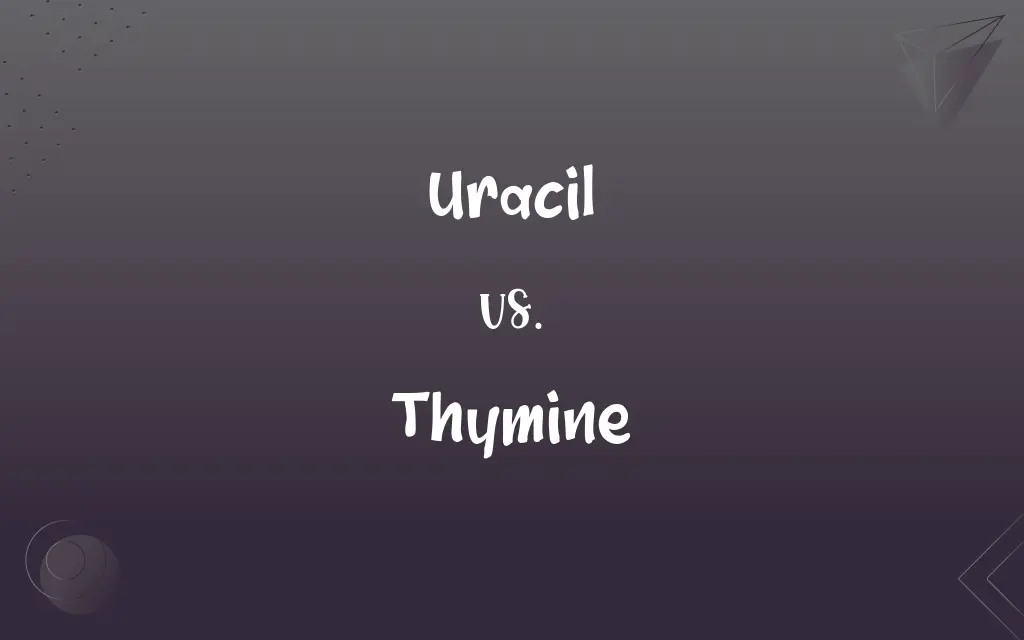Uracil vs. Thymine: What's the Difference?
Edited by Harlon Moss || By Janet White || Published on November 29, 2023
Uracil is a nitrogenous base found in RNA, replacing thymine, which is found in DNA; both pair with adenine but differ in chemical structure.

Key Differences
Uracil is one of the four nitrogenous bases found in RNA (ribonucleic acid), playing a crucial role in the synthesis of proteins from genetic information. It pairs with adenine during the process of transcription. Thymine, on the other hand, is found in DNA (deoxyribonucleic acid) and also pairs with adenine, but it is part of the process of replication and transcription in DNA.
Structurally, uracil is a pyrimidine base, characterized by a single ring of carbon and nitrogen atoms. Its presence is one of the primary factors that distinguish RNA from DNA. Thymine, also a pyrimidine base, differs from uracil by having a methyl group in its chemical structure, which makes DNA more stable than RNA.
In terms of function, uracil is crucial in RNA for protein synthesis, as RNA acts as a messenger and template for assembling amino acids into proteins. Thymine’s role in DNA involves storing genetic information in the organism's genome and is key to maintaining genetic integrity across cell divisions.
Uracil's presence in RNA reflects the transient nature of RNA molecules, which are not meant for long-term storage of genetic information but rather for immediate use in synthesizing proteins. Thymine’s presence in DNA contributes to the stability and longevity of DNA molecules, essential for the long-term storage of genetic information.
From an evolutionary perspective, uracil is considered to be an older molecule than thymine. The replacement of uracil with thymine in DNA is thought to be an evolutionary adaptation that increased DNA's chemical stability and reduced the mutation rate, which is crucial for the development of complex organisms.
ADVERTISEMENT
Comparison Chart
Location
Found in RNA
Found in DNA
Chemical Structure
Single ring structure, lacks a methyl group
Single ring structure with a methyl group
Pairing
Pairs with adenine in RNA
Pairs with adenine in DNA
Role
Involved in protein synthesis
Involved in storing genetic information
Stability
Less stable, suitable for short-term use
More stable, suitable for long-term genetic storage
ADVERTISEMENT
Uracil and Thymine Definitions
Uracil
One of the four nucleobases in the nucleic acid of RNA.
RNA strands are composed of adenine, guanine, cytosine, and uracil.
Thymine
A base in DNA that pairs with adenine.
Thymine forms base pairs with adenine in DNA strands.
Uracil
A base in RNA that pairs with adenine.
Uracil forms base pairs with adenine during transcription.
Thymine
One of the four nucleobases in the nucleic acid of DNA.
DNA is composed of adenine, guanine, cytosine, and thymine.
Uracil
A component in the synthesis of proteins from RNA.
Uracil plays a critical role in translating genetic code into proteins.
Thymine
Involved in storing and transmitting genetic information.
Thymine is crucial for the integrity of genetic information in DNA.
Uracil
A pyrimidine base found in RNA molecules.
Uracil replaces thymine in RNA.
Thymine
A pyrimidine base characterized by a methyl group.
The methyl group in thymine makes DNA more stable than RNA.
Uracil
Distinguishes RNA from DNA by its presence.
The presence of uracil is one of the key differences between DNA and RNA.
Thymine
Contributes to the stability and longevity of DNA.
Thymine’s chemical structure helps in maintaining DNA's long-term stability.
Uracil
A pyrimidine base, C4H4N2O2, that is an essential constituent of RNA.
Thymine
A pyrimidine base, C5H6N2O2, that is an essential constituent of DNA.
Uracil
(organic compound) One of the bases of RNA, pairing with adenine.
Thymine
A heterocyclic base, 5-methylpyrimidine-2,4(1H,3H)-dione; it pairs with adenine in DNA.
Uracil
A nitrogen-containing base found in RNA (but not in DNA) and derived from pyrimidine; pairs with adenine
Thymine
A base found in DNA (but not in RNA) and derived from pyrimidine; pairs with adenine
FAQs
What replaces thymine in RNA?
Uracil replaces thymine in RNA.
Is thymine present in RNA?
No, thymine is exclusive to DNA.
Does thymine contribute to DNA stability?
Yes, thymine's methyl group contributes to DNA’s chemical stability.
Does thymine pair with guanine?
No, thymine pairs with adenine in DNA.
Is uracil part of DNA repair mechanisms?
No, uracil is not typically involved in DNA repair.
Can uracil be methylated?
Yes, uracil can be methylated in certain biological processes.
Can the presence of uracil in DNA indicate damage?
Yes, uracil in DNA often suggests a mutation or damage.
Is uracil’s structure similar to thymine’s?
Yes, except uracil lacks the methyl group present in thymine.
Does thymine form hydrogen bonds with adenine?
Yes, thymine forms two hydrogen bonds with adenine.
What does thymine pair with in RNA?
Thymine does not pair in RNA, as it is not present in RNA.
Is uracil found in DNA?
No, uracil is only found in RNA.
Is thymine more stable than uracil?
Yes, thymine is more chemically stable due to its methyl group.
Are uracil and thymine derivatives of each other?
No, they are distinct compounds, although chemically similar.
Does thymine play a role in transcription?
Yes, thymine is involved in DNA transcription.
Why is uracil used in RNA instead of thymine?
Uracil is less complex and cheaper for cells to produce, suitable for RNA's short-lived nature.
Are uracil and thymine interchangeable?
No, they have distinct roles in RNA and DNA.
Can mutations convert thymine to uracil?
Yes, chemical changes can cause thymine to deaminate to uracil.
Does uracil affect RNA’s function?
Yes, uracil plays a key role in RNA's function in protein synthesis.
Is thymine found in all living organisms?
Yes, all organisms with DNA contain thymine.
Can uracil bind with cytosine?
No, uracil pairs with adenine in RNA.
About Author
Written by
Janet WhiteJanet White has been an esteemed writer and blogger for Difference Wiki. Holding a Master's degree in Science and Medical Journalism from the prestigious Boston University, she has consistently demonstrated her expertise and passion for her field. When she's not immersed in her work, Janet relishes her time exercising, delving into a good book, and cherishing moments with friends and family.
Edited by
Harlon MossHarlon is a seasoned quality moderator and accomplished content writer for Difference Wiki. An alumnus of the prestigious University of California, he earned his degree in Computer Science. Leveraging his academic background, Harlon brings a meticulous and informed perspective to his work, ensuring content accuracy and excellence.







































































